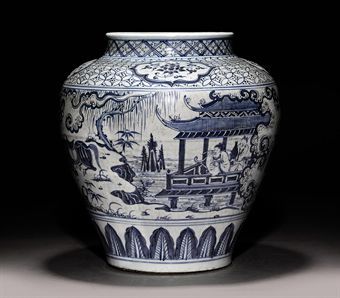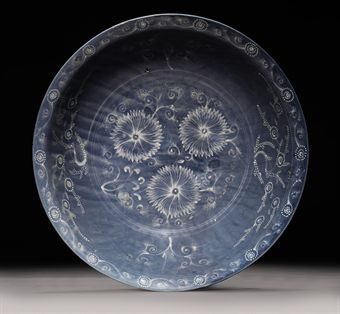Ming blue & white porcelains @ Christie's. Fine Chinese Ceramics and Works of Art. 11 May 2010. London
A blue and white 'Windswept' jar, guan. Ming dynasty, 15th century. photo Christie's Ltd 2010
Of baluster form, painted in underglaze blue in the 'windswept' style, with an official seated on the ground, with his horse resting nearby and accompanied by two young attendants, one carrying a qin, the other carrying his sword, another scene depicting an official in a pavilion in a riverscape, with an attendant bearing a vase, all below billowing clouds, with quatrefoil panels and lotus blossom sprays against a diaper ground on the shoulder, the neck with a further classic border, the base encircled by a series of upright plantain leaves - 15½ in. (39.4 cm.) high. Est. £30,000 - £50,000 ($44,100 - $73,500)
Notes: The present jar belongs to a group of large blue and white jars and meiping of the 14th-16th centuries, depicting figures in landscapes and garden settings, that are taken from traditional literature and popular drama. The panoramic landscape scene is comparable to handscroll paintings of the early Ming period, although on the ceramic painting it required the joining of the scene at one side of the body by a series of stylized cloud scolls to bring about an element of continuity.
Compare this jar to others painted in the same 'wind-swept' style illustrated in Sekai toji zenshu, vol. 14, Tokyo, 1976, nos. 231-2, middle and bottom rows, which also show figures on horseback accompanied by attendants in landscape settings.
A blue and white 'lotus petal' dish. Wanli six-character mark within a double circle and of the period (1573-1619). photo Christie's Ltd 2010
Moulded as two rows of overlapping petals rising from a central medallion of a Tibetan/Sanksrit character bordered by bands of ruyi heads, the inner row of petals with trefoil motifs decorating the rounded tips, the outer lotus petals forming a barbed rim, the exterior painted with Tibetan/Sanskrit characters alternating with flower sprigs above a row of projecting petal tips rising from a further narrow band of overlapping petal tips painted in a linear manner above the small ring foot - 7¾ in. (19.5 cm.) diam. Est. £15,000 - £20,000 ($22,050 - $29,400)
Notes: Other examples of lotus-form bowls with Wanli marks are illustrated by J. Ayers, The Baur Collection, vol. II, Geneva, 1969, no. A185; by Wang Qing-zheng, Underglaze Blue and Red, Shanghai, 1987, pl. 101; by J. Harrison-Hall, Ming Ceramics in the British Museum, London, 2001, p. 313. Other recorded examples include one in Oriental Ceramics, The World's Great Collections, vol. 11, Metropolitan Museum of Art, Tokyo, 1982, no. 91. Another bowl of Wanli date, but unmarked, in the Institut Neerlandais, Paris, is illustrated by D. Lion-Goldschmidt, Ming Porcelain, New York, 1978, pls. 215 and 215a, where the author notes that these bowls were probably intended to hold offerings in a Lamaist Buddhist temples.
Compare, also, the dish formerly in the Jingguantang Collection, sold in our New York rooms, 20 March 1997, lot 81.
A rare blue and white 'lotus bouquet' dish. Ming dynasty, 15th century. photo Christie's Ltd 2010
Delicately potted with gently rounded walls ending on a flaring rim, the interior finely painted with a bouquet of lotus blooms tied with a long flowing ribbon, the reverse with the 'Eight Buddhist Emblems', bajixiang, supported on lotus blooms borne on meandering scrolls - 8¾ in. (22.5 cm.) diam. Est. £15,000 - £20,000 ($22,050 - $29,400)
Provenance: Sir George Labouchère, of Dudmaston Hall, Shropshire.
A rare blue and white 'Three friends of winter' stem cup. Ming dynasty, mid-15th century. photo Christie's Ltd 2010
The flaring bowl finely painted around the exterior with the 'Three Friends of Winter', pine, prunus and bamboo, the high foot with a band of pendent leaves above a lappet band at the foot, the interior with a floral spray - 4¾ in. (12 cm.) high, old fitted case. Est. £15,000 - £20,000 ($22,050 - $29,400)
Exhibited: The London Asian Art Fair, 2003, Porcelain for Emperors, no. 9.
Notes: This elegant stem cup is decorated in painterly style with the decorative theme known as suihan sanyou,'Three Friends of Winter'. The decoration is composed of bamboo, pine and blossoming prunus, depicted here with rocks and clouds. The pine, bamboo and prunus, are sometimes seen as representing Daoism, Confucianism, and Buddhism. However, these plants are also thought to represent the personal qualities of a gentleman - prunus symbolizes perseverance and purity, while its flowers have five petals and five is a sacred number, in this case representing the five blessings; pine is symbolic of nobility and venerability; while bamboo symbolizes humility and fidelity. In addition, the pine and bamboo are evergreen, and thus are admired for remaining green throughout the cold winter months, while the blossoming of the prunus is welcomed as a harbinger of spring, since it is usually the first plant to bloom each year. The pine is also an important symbol of longevity. Known for its ability to bend without breaking, bamboo also symbolizes the integrity of the scholar who, although he may be forced to bend with the wind of adversity, will remain morally upright. In Chinese the word for the joints of the bamboo jie is the same as the word for integrity.
Although this design first appeared on blue and white porcelains in the Yuan dynasty, it came to particular prominence in the Xuande reign (1426-35), when it was used to decorate a range of different vessel forms, including blue and white stem cups such as the example preserved in the National Palace Museum, Taipei (illustrated in Catalogue of the Special Exhibition of Selected Hsan-te Imperial Porcelains of the Ming Dynasty, Taipei, 1998, pp. 262-3, no. 104), which is slightly smaller than the current stemcup. The painting of this subject in the Xuande reign had great vitality and used different densities of cobalt blue to good effect. In the Chenghua reign (1465-87), the three Friends of Winter remained a much admired design, but in the later part of the reign the painting style developed a refinement, and a restrained quality, echoed by a more uniform tone in the blue pigment.
A stem cup in the collection of the Palace Museum, Beijing (illustrated in The Complete Collection of Treasures of the Palace Museum 35 Blue and White Porcelain with Underglaze Red (II), Hong Kong, 2000, pp. 32-33, no. 30), is very close to the current stem cup in size, shape, and decoration, although the Beijing stem cup lacks the band of pendant leaves around the stem. The Beijing stem cup, which is preserved from the Qing court collection, is dated to the Chenghua reign, but in view of the less restrained style of the painting on the current stem cup, it seems possible that the latter either slightly pre-dates the Chenghua period, or dates to the early part of the reign, when the painting on blue and white porcelains still retained the vitality of the Xuande period.
A large zhangzhou (swatow) slip-decorated bowl. Ming dynasty, late 16th-early 17th century. photo Christie's Ltd 2010
With deep sides, the center of the interior decorated with a flowering stalk bearing three blossoms amidst feathery leaves, below alternating foliate sprays in the cavetto and a decorative border on the everted rim, all in white slip applied in dots, thin lines and wash on a soft blue ground which continues onto the exterior - 15¾ in. (39.5 cm.) diam. Est. £5,000 - £7,000 ($7,350 - $10,290)
Notes: A very similar dish is in the British Museum (see J. Harrison-Hall, Ming Ceramics, London, 2001, p. 347, no. 11:187); and a slightly smaller dish (38.1 cm.) is in the Metropolitan Museum of Art, New York, illustrated in Oriental Ceramics, The World's Great Collections, Tokyo, 1977, vol. 11, fig. 100.
Christie's. Fine Chinese Ceramics and Works of Art. 11 May 2010. London, King Street www.christies.com

/https%3A%2F%2Fprofilepics.canalblog.com%2Fprofilepics%2F1%2F0%2F100183.jpg)







/http%3A%2F%2Fstorage.canalblog.com%2F93%2F29%2F577050%2F66520041_o.jpg)
/http%3A%2F%2Fstorage.canalblog.com%2F38%2F84%2F119589%2F66518392_p.jpg)
/http%3A%2F%2Fstorage.canalblog.com%2F89%2F15%2F119589%2F66422513_p.jpg)
/http%3A%2F%2Fstorage.canalblog.com%2F64%2F75%2F577050%2F65928955_o.jpg)